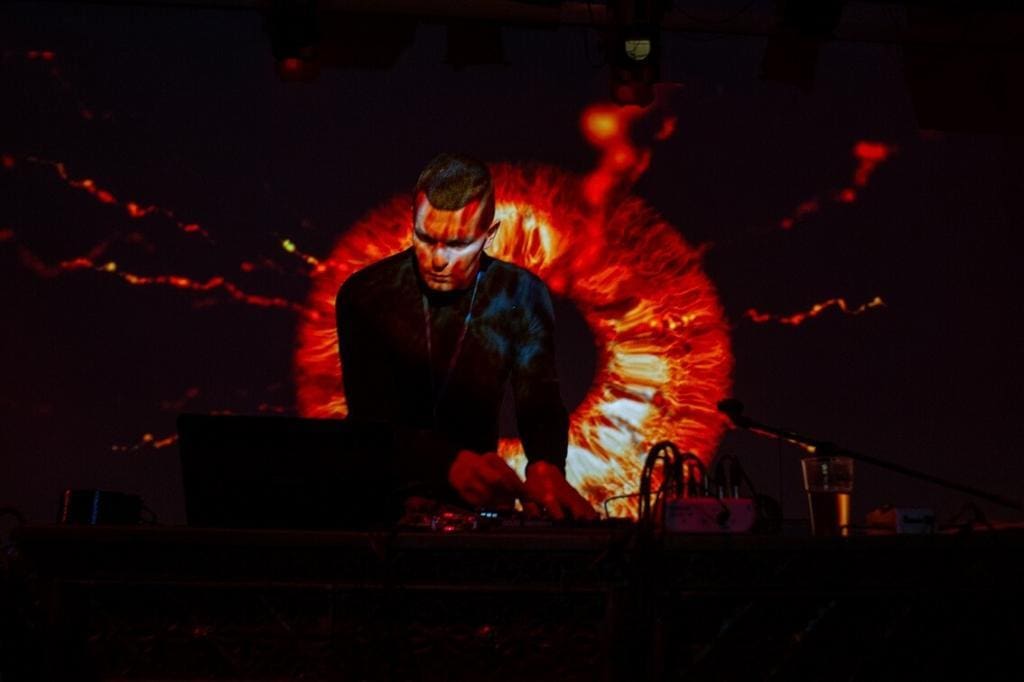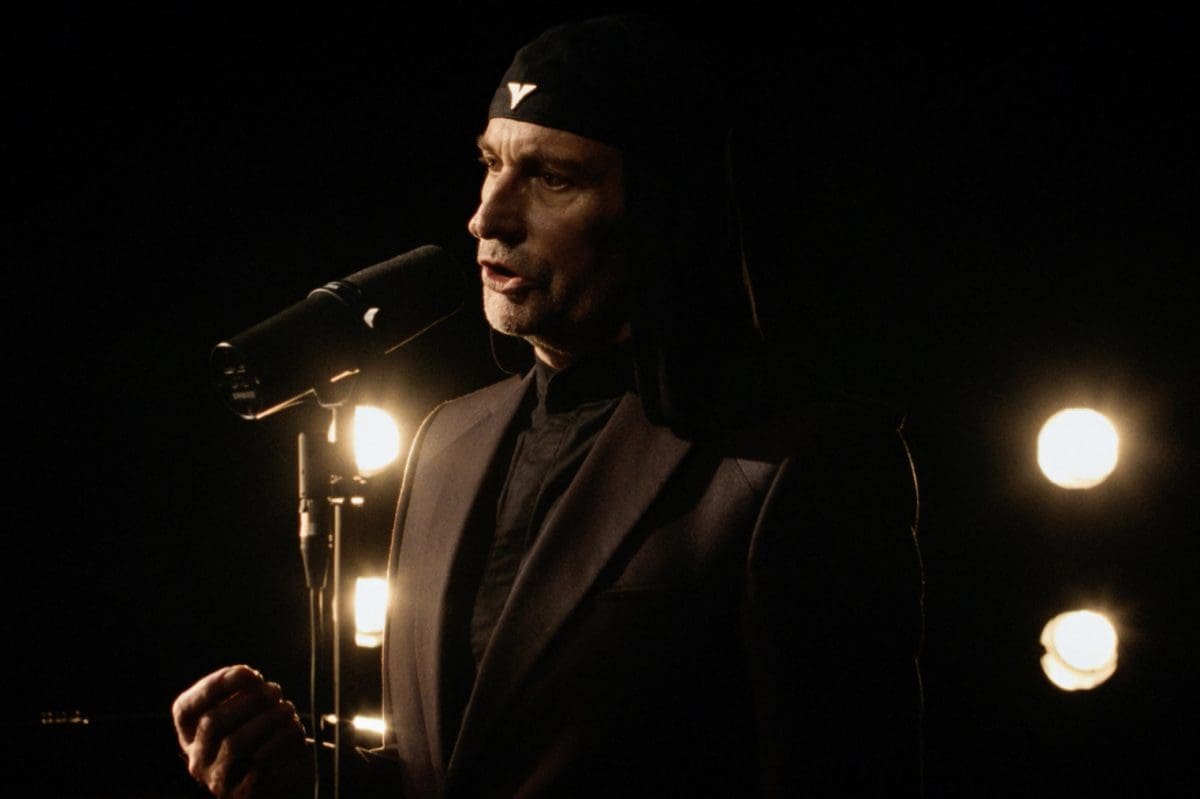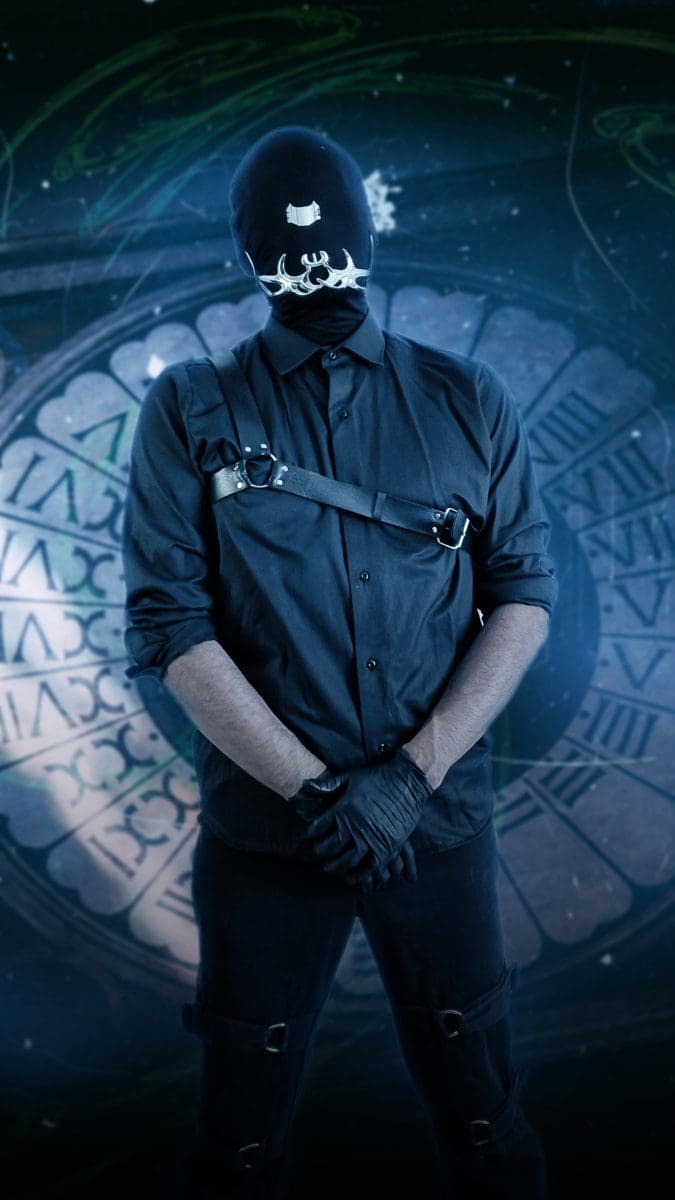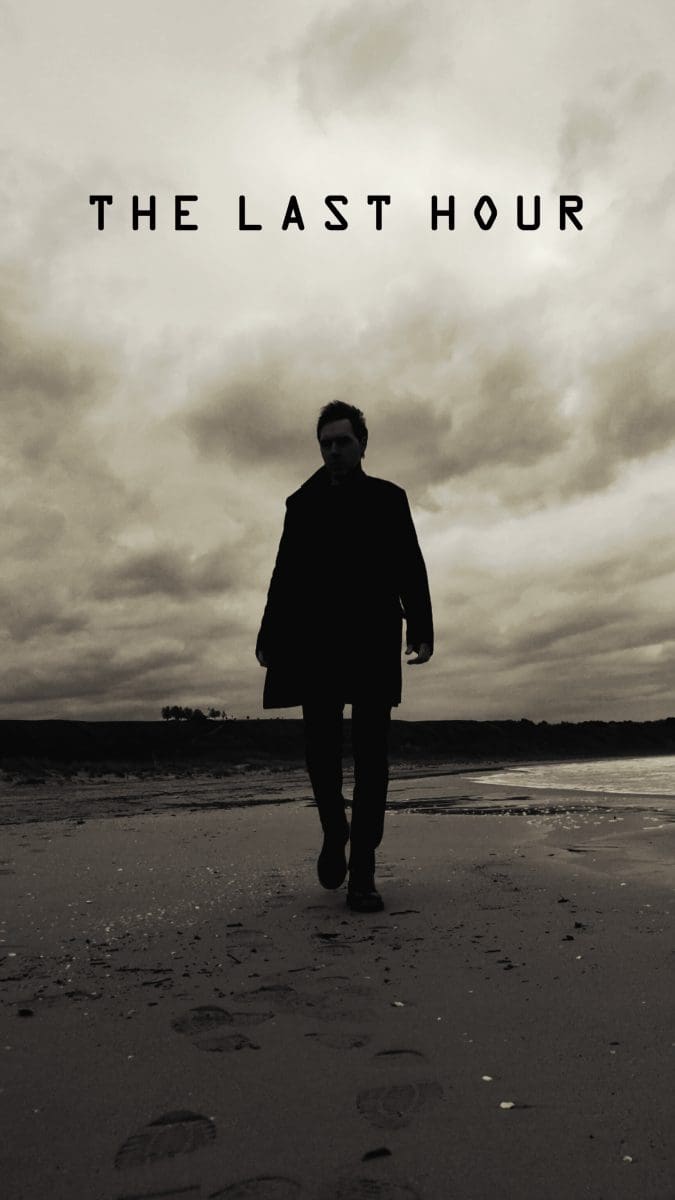’30 Years Of Journalism – Celebration Interview’ with Peter Andersson / Raison D’Être: ‘Music Had Much More Mystery Surrounded To It In The 80’s And 90’s’

I’m honoured Peter Andersson accepted doing this interview to celebrate my 30th anniversary as journalist. He remains without a shadow of a doubt one of the absolute masters in Dark-Ambient music, but he this year also celebrates the 30th anniversary of his main music project Raison D’Être. So to me this interview became a way to pay homage to this genius artist. He definitely injected new ideas in the ‘Ambient’ genre, creating tormenting and sometimes disturbing atmospheres with a strong visual appeal. I often experienced his work as a mirror reflecting the inner world; a way to face our most hidden inner demons and experience feelings of despair, desolation, solitude…
(Picture credits by Kirche / Interview courtesy by Inferno Sound Diaries)
Q: 2021 must be a special year to you as Raison D’Être is celebrating its 30th anniversary. What comes directly into mind when evoking these 30 years of creation and involvement? What are the greatest points of satisfaction and disillusion?
Peter: The immediate feeling is, wow, that is a long time, and time goes fast. Not that I ever thought I would not make music after 30 years. During these 30 years I have done a lot of music, for a lifetime. But I will not stop, so rest assure, I will continue another 30+ years if health is with me. Music is such a big part of my life, and utterly important for my well-being.
I think every new album has been a great satisfaction. Working on the music, being immersed in the creative process, realize a plan, and being overwhelmed and thrilled about the outcome, that is a lot of satisfaction in there. On the way there has been some disillusion, I guess. In the mid 90’s I thought it was possible to live on making music and to do live performances, but such a dream became impossible when the illegal downloading started, and CD sales sharply went down. But there are really not many big moments of disappointment or so.
Q: How much of the young Peter Andersson do you still recognize in your approach and spirit of composing music today?
Peter: I think I still have a playful approach when creating sounds. I have always been attracted to sounds and to make or play sounds from both real instruments and from anything that can make noise. I can’t really play any instrument, so the approach has always been to experiment. A famous Electronic composer once said: ‘if someone gave me an acoustic guitar, I would not know what to do with it except using it as a pot for a flower’. So, we see various use for the same things depending on our needs, which may differ from time to time, and this kind of limitless approach is still with me.
Q: I can imagine you must have seen a lot of things changing and evolving over the years; the way of making and producing music, the formats of releasing music (from cassette to digital), the rise of streaming platforms, the impact of social media etc… What do you think about these changes/evolutions and what do you see as the pros and cons?
Peter: Yes, it has been a revolution in many ways. Music making and distribution has become much more democratic. Everyone can do it; all you need is a computer really. There are many fantastic things with the new technology. It is also many downsides, a mess really, too much of everything, very difficult to get your voice heard or to get visible at all. It is like drowning in a sea of shit, not easy to pick the cherries.
I might be a bit nostalgic, but I think music had much more mystery surrounded to it in the 80’s and 90’s. You could almost only read about the music and artists in obscure magazines, and it could be a difficult task to buy physical releases, especially from a foreign mail order, but when you did you treated the album like it was something holy. I do not get the same feeling now.
Q: Back in time I got the feeling Raison D’Être was bringing a different kind of Dark-Ambient; I mean different from what we’ve heard in the 80s. What was your original perception about the music you composed? Did you’d specific references and criteria?
Peter: If you google a bit on the Dark-Ambient genre you will see on Wikipedia that Roger K, head of Cold Meat Industry, coined the term Dark-Ambient to describe the sound of Raison D’Être. So, if this is true then I was doing the right kind of Dark-Ambient and everybody else must have done something else or being copies of me, or something.
So, no Dark-Ambient music in the 80’s, it was called something else. I grew up and listened to the music of the 80’s in the 80’s, and of course many bands had a great impact on me and when I started to make music in the end of that decade and more seriously in the early 90’s I created something that was my own unique sound, but with influences of those older bands. It is a pretty natural process to be influenced and then making something new out of those influences. Even if I could be influenced by bands there were no perfect band. They always had some annoying element in their songs or just too much bad song material around a few good song materials.
What I wanted to do was something perfect, for me 100% perfect. Something that I could enjoy that was not annoying. If it were annoying, I could do something about it because I created the song and had access to how the song was constructed.
Q: What did you keep in mind from your early compositions? Was there a specific way of working and how did it evolve throughout the years?
Peter: Back in the earliest days it was much about melodies and rhythms, so it started mostly by composing a melody or a rhythm and evolve from that. The equipment was just basic stuff and functions. I had no experience whatsoever so there were many trial and error moments. It could take many hours to tweak sounds because the displays were so small. I remember the first sampler I used, poor quality thing and expensive special sized floppy discs to save sound, one sound on each side of the disc. Instead, I sampled the sounds from the cassette sources each time I wanted to work on a specific song and remember all the edits. I had all such edit information written down on a paper, but it was difficult to get it right. So, each time it sounded a bit different just because of loading the sounds.
I did plenty of tracks in the beginning, I could do one a day for a month or so. Things were complicated back then, but songs were simple constructed, so it was a straightforward way to work. And maybe I was unpretentious back then, I just did things. It was just fun making music, so I did a lot of music.
Now is a different story. I am much more aware of what I am doing and what I want. I try to make it all perfect. I do not make loads of tracks just because it is possible. I follow concepts and are aiming for certain goals. And now, the equipment is high class, almost anything I possible, tweaking sounds on a surgical level, and it is easy to recall a track with one button. The tools become more advanced for every new album, so gradually my sound universe became larger for each time. Today I start with making a lot of sounds, tweak them to perfection. I am not so much into melodies and rhythms now (at least not for Raison D’Être), it is more about creating specific atmospheres with intriguing sounds. Compositions are much more complex today than in the early years. The sounds are also much more complex and varied. I strive to get an organic quality of the sounds. Maybe things were more spontaneous in the early days, a free feeling just doing stuff, but I like to have some goals with things, think about the whole package and follow concepts.
Q: You got directly signed to Cold Meat Industry, which was a leading label from the Dark-Ambient genre. CMI has been often introduced as a ‘big family’, but how did it really feel and are you still in touch with some CMI artists?
Peter: Most of the bands were really close, so yes, it was shaped like a big family. When we went on tours in the 90’s and early 00’s we were like 15 bands in three minibuses and it was great. Of course there were some fractions and people who preferred some better than others, but still we were a solid gang. Most of us also originated from the same region in Sweden, probably helped and strengthened the family bounds.
Occasionally I acted like a support centre, people from many of the other bands called me and asked how do to things. Simple things like how to connect this equipment to that equipment, or more complex like what do you think about this working method instead of doing it in another way. I am still impressed that some bands could even make any music at all because they had no knowledge how their equipment worked. Now, when CMI since not exist anymore I still have good contact with many of the bands, especially Brighter Death Now, Deutch Nepal, IRM and Desiderii Marginis. Sometimes I see people from other CMI-bands, when there are occasionally bigger festivals with CMI theme, then we got a chance to see each other again. It’s always a great time.
Q: I know it’s always difficult for artists to give a favourite album and/or song, but I can imagine there must be productions/songs, which are more important to you than others? And which song/album would you chose to make listen to people who don’t know your work?
Peter: For me, my latest album is always the most important. I mean, that is my latest creative and psychological development and something that I recently put all my effort into, and something I can relate to because it is now. It is difficult to say something means anything to me now that I did 25 years ago. It did mean something or everything back then, but not now.
If I must say an album of the past I would say “The Empty Hollow Unfolds” because it was voted to be the best release ever on Cold Meat Industry. So, that albums mean a lot to my listeners, and it has a pretty unique sound that stand out from every other album from Dark-Ambient bands done around that time. For a newcomer I would probably choose something more easy listening, like “In Absence Of Light” from “In Sadness, Silence And Solitude”.
Q: I a previous interview you said to be fascinated by the inner world; dreams, subconscious and unconscious, archetypes, symbols and imagination… It all reminds me to the psychology courses and the work of Freud and Jung. Do you feel related with their work and what’s the importance of the inner world in your life vs. artistic life?
Peter: What is going on inside us, in the inner world, is absolutely fascinating and important, because it is completely about oneself and there is a lot of hidden potential inside us, I believe.
I am not much into Freud, but to Jung, his world is much more diverse and complete. Jung is basically fundamental for understanding Raison D’Êtreand my own personal life. I see no difference between my life and the artistic life, they are one and the same. I use music as one way to get knowledge of my inner self, and Jung’s theories are there for guidance. I do not say that Jung is right or so, but he offers interesting tools to make the inner life better understandable and to realize the one’s true self.
Q: In which way does the ongoing pandemic has an impact on your personal inner world and its connection with music creation?
Peter: Well, for me the pandemic did not change much really. I live pretty much isolated in the forest so I would not even notice if the civilisation would end, it almost feels like that at least. In Sweden we did not close down things in the way most the rest of the world did. We just try to keep distance here, without having any lockdown, curfews, or other drastic restrictions. So, I still have/had to get to my work, but with optional working from home if I can.
So, life is and was pretty much normal, and did not affect the creativity in any particular way. I guess it must have been very difficult to be inside a small apartment for months only to get out a few times to buy stuff at the supermarket. Not inspiring at all, and I suffer with those who experienced a lockdown.
Q: Next to Raison D’Être you’ve been involved with an impressive number of side-projects. Which ones are still active today and where does this need to get involved with multiple projects comes from?
Peter: I do not want a particular style of music to limit my ideas. Creativeness may go any direction and you do not know what it will bring, but something. It is an ocean of possibilities. Nevertheless, I do not want to confuse people. So, I have a lot of projects instead.
Sure, I could have used one project name making various styled music and albums, but what about the audience. Some people say they cannot hear much difference between let us say Raison D’Êtreand Necrophorus. I think it is a vast difference. It is totally different concepts, methods, directions and sounds. Sometimes they are crossing, but that is just on short term or mere coincidental. A band like Controlled Bleeding could change direction on every new album, and I just got confused and almost sad. So, I do not want to make the same mistake for my followers.
My side projects Cataclyst, Svasti-Ayanam, Panzar and Grismannen are not alive at all. Stratvm Terror has been dead a little while, but it has slowly come alive again. Bocksholm and Necrophorus are slow projects at the moment, but things are happening soon. It is only Atomine Elektrine and Raison D’Êtrethat have been active lately. So, still several side-projects to nurse and care for.
Q: How do you make the difference between all different music projects and how do you switch from one till the other?
Peter: I almost never work with more than one project at time. I want to fully concentrate on one album, not run two or more different albums or projects the same time. So, having a lot of projects have not really caused me any confusion and the switching is easy since I complete an album before starting another one with another project, and having some rest in-between.
Q: Most of your work always had a very strong visual appeal, but how strong is your connection with visual expression and arts? Is there a work (movie, picture, painting…) you feel related with and, which in a way could symbolize your work as musician and especially Raison D’Être?
Peter: When composing I do not visualize my music very much. I might evoke some imagery, but it is less important. The starting point when composing is often just words: the title and basic concept. Then I follow my intuition and emotions response. However, many tells that my music got a very visual expression, and that is probably true for not only my music, but the whole Dark-Ambient genre. I often create dramatic atmospheres or soundscapes which may evoke sinister or beautiful things, and that is pretty much what can sometimes be seen in a movie or a picture or a painting too.
Paintings has been inspiring, for example the darker work of Hieronymus Bosch. At least in the earlier stage Bosch paintings could symbolize some of my work. In the mid 90’s I did a homage to Salvador Dali, by selecting six of his paintings to score (released by my side-project Necrophorus). That music needed to be visualized the very moment it was created.
Q: But you composed music for ‘film and exhibition’ so what have been your experiences so far? Does the production need a specific and/or different approach than for ‘normal’ productions?
Peter: It is indeed different making music for film and exhibition. Until now I have only made scores for my own short films, so it would probably be different to work with professional made movies.
For scoring film I have needed to adapt the music to frames and the story, follow the movie frame by frame. So, the score is very bound to the movie and its visual components. In normal production cases there are no visuals to adapt to, but the music can induce visuals to appear in the eye of the beholder, but that is something else. Music for exhibition is a bit more of a free bird than music for movies, but still many things to care for, many rules.
The exhibition music should enhance the visitor experience for everyone without being disturbing. The mixing should be done in the exhibition room using the final speakers. Length must be adapted to the typical length of a visitor experience. I prefer making music free of any rules or framing but I must admit it can be very interesting to make music with some limitations or under certain conditions, if the theme is interesting enough.
Q: You this year released a new Raison D’Être album entitled “Daemonum”. As most of your album titles, this once again sounds very intriguing. What did you try to express and how do you see this album in the wide discography of the project?
Peter: Basically, the whole “Daemonum”-album is a journey from start to end, a dive into the subconsciousness that goes deeper for each track, much like my previous albums “Alchymeia” and “Mise En Abyme On “Daemonum” the search is for the Shadow archetype, specifically the Anima/Animus representation. Each track renders one step on the path to finally reach the Anima/Animus. On such a journey one must face different parts of the unconsciousness, and not all pleasant things, one’s weaknesses for example. But for each journey one become stronger and has better understanding of the inner self. I am much into the ideas of Carl Gustav Jung as we talked about earlier. I have been dealing with his psychoanalytic theories in many, if not all, of my previous albums. So, this is another journey inside the subconsciousness, now dealing with the secrets of the Shadow archetype in form of the Anima or Animus (which is that inner voice, a Daemon). This is a part of how to get better knowledge and find hidden potential within ourselves, and part of the process of self-realization, which is the very foundation in the Raison D’être project itself. As with every new album, I see this as the pinnacle of Raison D’Être. I try to keep pushing things forward, so the next album will be even better, and be the next pinnacle moment. Each album is like climbing a mountain, when you are on the top you see another higher mountain ahead of you to climb.
Q: What are you doing in between two albums? I mean what keeps you busy next to music?
Peter: I am resting, accumulating energy for the next creative output. I do a lot of mastering jobs for bands and labels. I try to avoid such work during the making of an album, but in-between albums I have some spare time. I have a regular job as well, being an exhibition producer on a museum. I cannot live on music alone. And I have a girlfriend, house and garden that needs care. So, I am far from doing music all days, it is just some weeks of the year that I put on music making. That is why it can take three years to complete an album.
Q: How do you expect yourself evolving after 30 years of Raison D’Être?
Peter: Well, yes, what to expect? Maybe that things make more sense in life, deeper understanding how things are connected, and I have a more mature approach to things in general than 30 years ago. But I am not sure, it can be the other way around really.
Since you’re here …
… we have a small favour to ask. More people are reading Side-Line Magazine than ever but advertising revenues across the media are falling fast. Unlike many news organisations, we haven’t put up a paywall – we want to keep our journalism as open as we can - and we refuse to add annoying advertising. So you can see why we need to ask for your help.
Side-Line’s independent journalism takes a lot of time, money and hard work to produce. But we do it because we want to push the artists we like and who are equally fighting to survive.
If everyone who reads our reporting, who likes it, helps fund it, our future would be much more secure. For as little as 5 US$, you can support Side-Line Magazine – and it only takes a minute. Thank you.
The donations are safely powered by Paypal.











